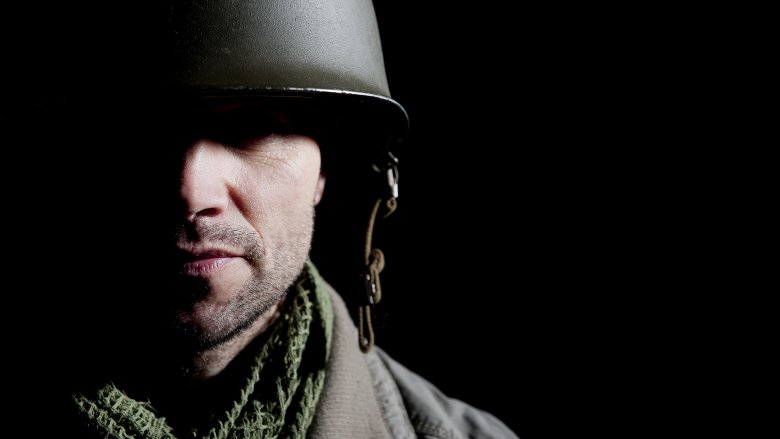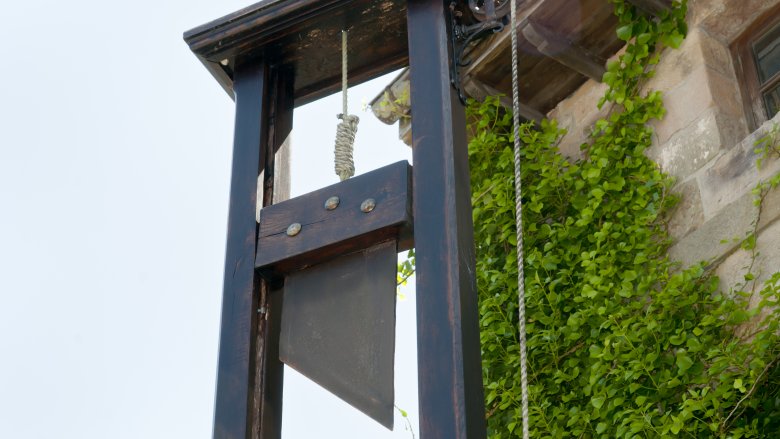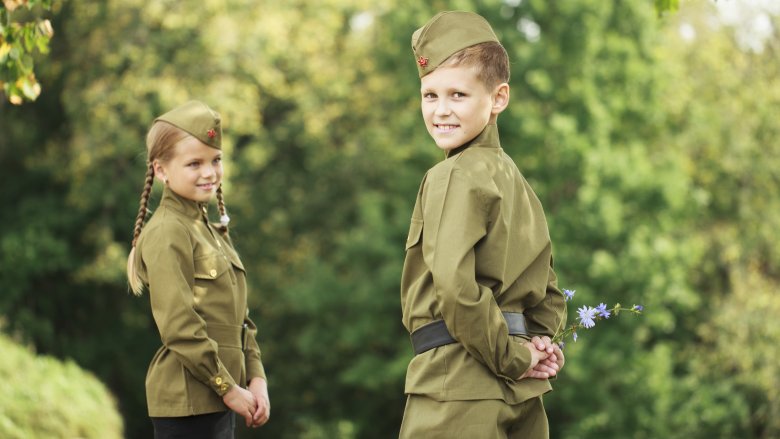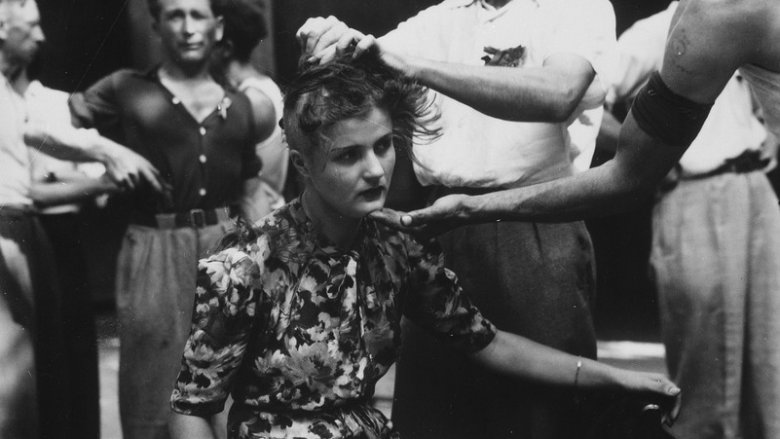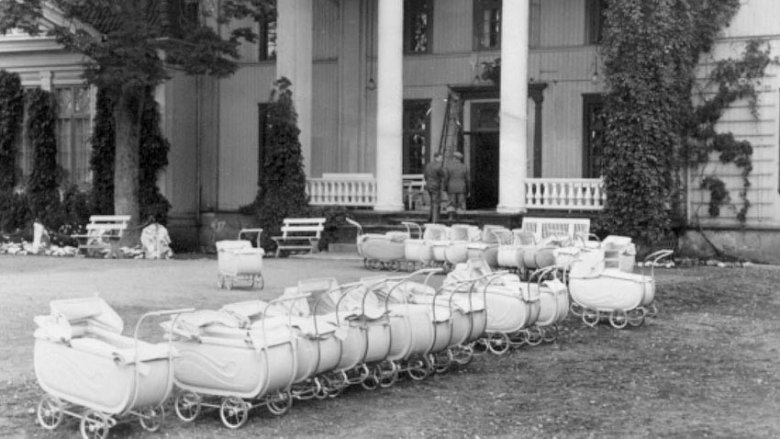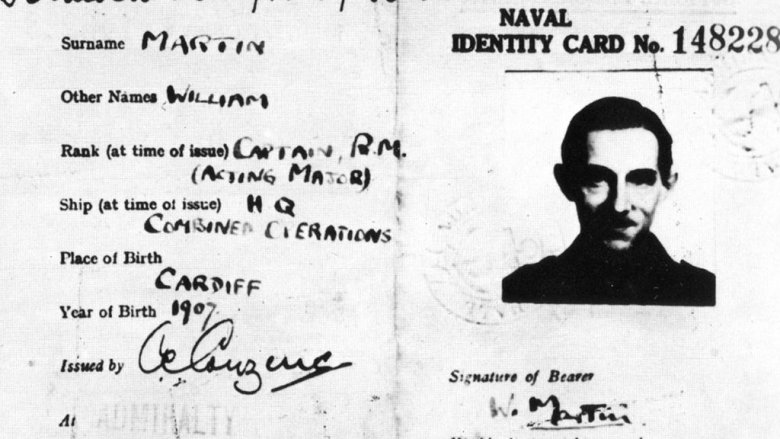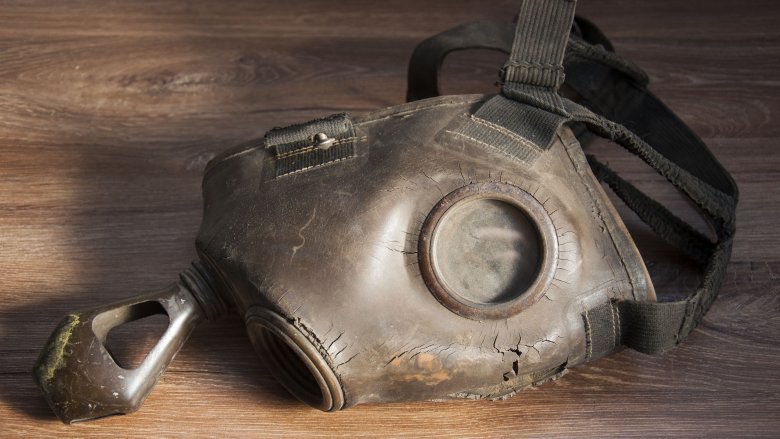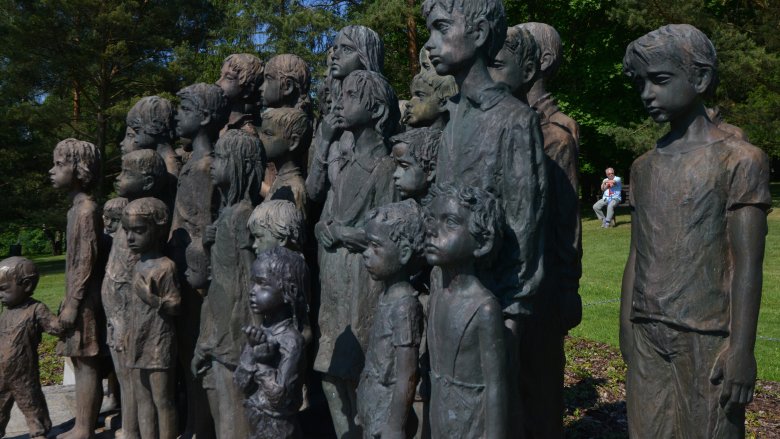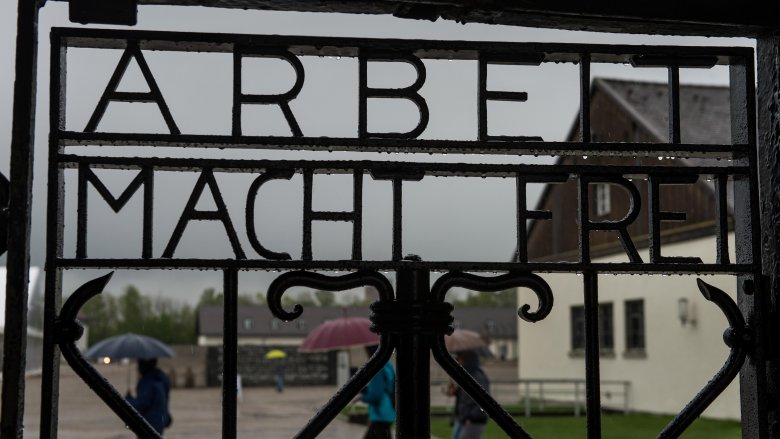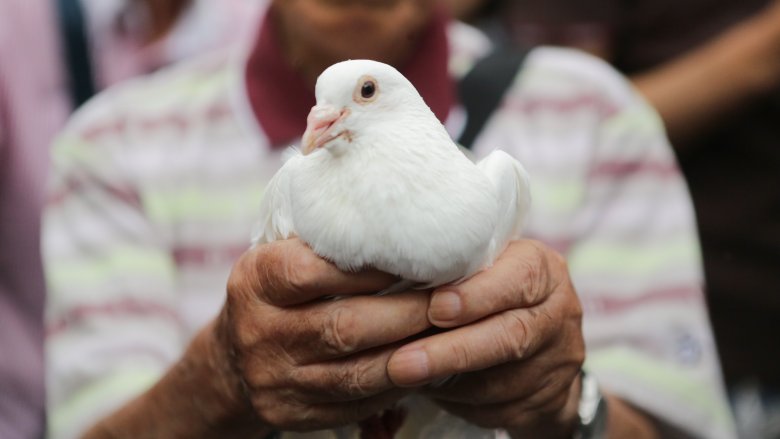Messed Up Things That Actually Happened During World War II
No matter how much you know — or think you know — about World War II, there are always more horrible things lurking in the shadows. We all know the war years were a terrible time, but let's talk about some of the messed up things about World War II that truly happened but are usually left out of history books.
The serial killer who preyed on Jews trying to escape France
His name was Marcel Petiot, and no one's sure how many victims there were. We do know he was born in 1897. He suffered a complete breakdown during World War I but earned a medical degree post-war in spite of recommendations he be institutionalized for reasons of insanity. He moved to Villeneuve, France, opened a medical practice, and was even elected mayor. It wasn't until the 1930s that a few patients died mysteriously (via Britannica).
World War II presented a brilliant opportunity for him; Petiot began an operation where he'd promise to help Jews escape the advancing Nazis. After telling them they were headed to South America, he'd inject them with a "vaccine." The shot was poison, and once they were dead he took all their worldly possessions, dismembered the bodies, then wrote letters to any family members saying they had escaped safely and would be back ASAP.
David King, who wrote Death in the City of Light: The Serial Killer of Nazi-Occupied Paris, says (via Reuters) it's possible he killed up to 150 people, although he was charged with 27 murders, was convicted of 26, and admitted to 60. Petiot was only captured after police and firefighters investigated a smoking townhouse and found scattered body parts there, and unsurprisingly he was nicknamed Doctor Satan. He met his end via guillotine in 1946.
The war's underage soldiers
Do you remember what you were doing when you were 12 years old? Calvin Graham does — he was serving on the USS South Dakota. It was 1942, and he dropped out of seventh grade to head off to basic training. He served in the Naval Battle of Guadalcanal, and said, "I took belts off the dead and made tourniquets for the living." He'd just turned 13.
Graham's story wasn't a happy one, and the Smithsonian says after the Navy found out how old he was, he was stripped of his medals, served some time in the brig, and was kicked out of the military without an honorable discharge. It took until 1994 to get benefits and medals returned to his family — he died in 1992.
He was just one of the so-called Baby Vets who grew up way too soon. Jack Lucas was 14 when he lied his way into the military, and became the youngest Medal of Honor recipient (at 17) for his actions at Iwo Jima (via The Seattle Times). Britain's Roy Bradshaw was given the Legion d'Honneur medal for his actions during D-Day, when he was 16 (via The Telegraph). And the BBC reported on the identification of Britain's youngest wartime casualty: Reginald Earnshaw. He died when he was 14 years old and serving on the SS North Devon.
Gerhard Kretschmar
In 2003, The Telegraph reported on the discovery of the name of the 5-month-old baby previously known as "Case K." His real name was Gerhard Kretschmar, and he died after his parents wrote to Hitler for permission to kill him.
When Hitler's personal doctor, Karl Brandt, testified at Nuremberg, he talked about Case K. He was sent to personally examine the boy, who had been born blind and missing a leg and part of his arm. After the doctor administered a drug that eventually led to a drawn-out death, Brandt says the incident was the catalyst for the euthanasia program called T4. According to Hitler's decree (via The Atlantic), these were people he considered "unworthy of living," and the program eventually led to the killing of more than 300,000 people with mental and physical disabilities, including newborn babies. Doctors were under strict orders to register any babies with conditions like Down syndrome or epilepsy with the government, while adults were funneled through a program eerily named the Charitable Foundation for Cure and Institutional Care.
Everything about the story is horrible, and it started with a baby who was called "The Monster" by his parents, Richard and Lina Kretschmar.
Les femmes tondues — the shorn women
The liberation of towns across France should have been an unconditionally happy day, but for countless women, it turned into days of public humiliation and shaming. Even as Allied troops ousted Germans across the French countryside, what The Guardian called "ugly carnivals" began. Woman accused of "collaboration horizontale" had their heads shaved in town squares, then were forced into trucks and paraded through the streets. In theory, they were being shamed for sleeping with the enemy, for collaborating with Nazi soldiers, and for choosing the wrong side. They were occasionally covered with tar, painted with swastikas, and stripped naked.
France was a hotbed of rumors during and after the occupation, and women were accused of acting as undercover operatives and even snipers for their German lovers. The truth was usually painfully different, and an estimated 20,000 women were essentially victim-blamed for their role in the war. Women paraded through the streets included those who were forced to turn their homes into bunkhouses for German soldiers, and mothers promised food for their starving children in exchange for favors. There are reports of Paris prostitutes kicked to death for having a German clientele, and according to Vice, the "collaboration horizontale" may have been rape, in some cases.
The vivisection of eight American POWs
Toshio Tono was a first-year student at Kyushu Imperial University's medical school in 1945, and when he spoke to The Guardian in 2015, he said it was his job to make sure the world remembered the unthinkable experiments done on eight American POWs in the final days of the war.
The men were captured after the crash of their B-29 Superfortress (like the one pictured). Four of the 12 died before they could be captured, and the others were taken to Fukuoka. Slowly, the POWs were escorted to the pathology department of the medical school. Tono told The Guardian, "I did wonder if something unpleasant was going to happen to them, but I had no idea it was going to be that awful."
Tono, the only surviving eyewitness to the vivisections, said the grisly experiments included injecting seawater into the men to see if it could be used like a saline drip, and removal of organs and parts of organs to see how long they could survive. One man had part of his brain removed to see if it would be an effective treatment for epilepsy. The bodies were originally preserved in formaldehyde for further study, but evidence of the crimes was destroyed as the war came to a close. Doctors stood trial, but no one was ever punished. Today, Tono — who was tasked with cleaning the blood off the floor — runs a maternity clinic, and displays documents in hopes the airmen won't be forgotten.
The Lebensborn
According to the Jewish Virtual Library, "Lebensborn" means "wellspring of life." It was also the name given to Himmler's selective breeding program, started with the goal of creating a generation to lead a nation of racially pure Nazi citizens.
The program officially started in 1936 with the opening of a Lebensborn home — complete with decor and prospective mothers hand-picked by Himmler himself — in a little village outside Munich. There were a few different stages of the program, but the first was the selection of men and women who could prove their racial purity and who were willing to bear a child who would be raised in SS nurseries. In 1939, the men of the SS were ordered to make as many racially pure babies as they could. (By 1942, the same men were told they could pick from non-German women, too, as long as they looked the part.)
As the Nazis expanded their control over parts of Europe, tens of thousands of children who fit their racial ideal were often stolen from their homes and shipped off to be "Germanized" through the same Lebensborn program. They were told they had been abandoned, were raised into Nazi doctrine, and then either adopted into the families of the SS or deemed lost causes and sent to concentration camps. You've probably even heard of the most famous of the children born to a Lebensborn mother: Anni-Frid Lyngstad, of ABBA.
Operation Mincemeat
Operation Mincemeat started in 1943, according to the BBC, with the untimely death of Glyndwr Michael. His body was found in a London warehouse, and his official cause of death was self-administered rat poison. His body wasn't buried, though. After spending three months on ice, he was outfitted with fake ID cards (like the one pictured), personal items from a thoroughly planned backstory, and some "top secret" documents. Then, he was dumped off the Spanish coast.
The entire thing was a plan to get those fake documents into the hands of the Germans via spies the Allies knew were operating in Spain. The plan worked. The documents got all the way to Hitler, who moved 90,000 soldiers to Greece based on the information, essentially clearing the way for the Allies to take Sicily and move into Italy. Sounds like something you'd see in a James Bond movie, right? Funny you'd think that, because it was intelligence officer Ian Fleming's idea.
Ireland's condemnation of the men who fought
There's been a lot of debate on whether wars have been necessary, but surely, no one could argue with someone who helped stop the Nazi advance across Europe ... right? Ireland did exactly that.
Then the Irish Free State, Ireland was neutral throughout the war, but 42,000 men (via The Telegraph) went to Britain to join the fight. There's a little bit of context needed, for anyone who's not familiar with Irish history. Ireland had only broken from Britain about 20 years prior, and it was a long, bloody fight with a lot of hate left on both sides. The men who left the home army to fight with the British were labeled deserters, and those who returned home found it wasn't the same place. Not for them, at least.
The BBC talked to some of the 5,000 Irish soldiers who found their names on a "starvation order" signed by the Irish government. These men served at the D-Day landings, liberated concentration camps, and fought at the Battle of the Bulge. When they returned, it was to hate from their neighbors, dismissal from the army, pensions and pay that were taken away, and a list of their names circulated with orders not to hire them. Many had no choice but to leave again, unable to find work or feed families. They were only pardoned for their service in 2013.
Race-based mustard gas tests in the U.S.
In 2015, NPR investigated mustard gas testing done on U.S. soldiers during World War II. It's even more messed up than you're thinking.
The experiments were declassified in 1993 and involved an astounding 60,000 enlisted men. Many of the men were selected just because of their race. It started with a group of white soldiers who were deemed the "control group," exposed to various levels of mustard gas to see what would happen. Then, groups of minorities were selected to undergo the same experiments to see if there was a difference.
And they were horrible experiments. Rollins Edwards was just following orders when he and a few others walked into a wooden room, only to find the door locked behind them and the room filling with gas. "It felt like you were on fire. ... Finally they opened the door and let us out, and the guys were just, they were in bad shape," he said.
To add insult to injury, the tests weren't listed on any medical records, and decades after the soldiers were exposed to chemicals known to cause things like leukemia, cancers, and emphysema, NPR found the VA had completely failed to even follow up with them on their health concerns. In 2016, NPR reported one soldier who had been a part of the tests and fought for government acknowledgement had died. Charles Cavell was 89.
The Lidice massacre and the man who survived
Lidice was a town in what was then Czechoslovakia, and it was the site of the 1942 assassination of a high-ranking Nazi official named Reinhard Heydrich. It's what happened after his assassination that's truly messed up.
The evening of Heydrich's funeral, the United States Holocaust Memorial Museum says SS and German police descended on Lidice. The 500 villagers were told to assemble in the village square. All 192 men and boys were taken to the outskirts of town and executed, while most women were sent to the Ravensbruck concentration camp, where 60 of the 203 died. Children who were deemed to have the appropriate physical features were sent off to undergo "Germanization," while 82 were sent to Chelmno's mobile gas chambers. Ten Lidice men who weren't there at the time were even tracked down and killed (via Medium).
Except for one. His story was told by Bohumil Hrabal in the book I Served the King of England and confirmed by Military Historical Institute historian Eduard Stehlik (via Radio Praha). Frantisek Sajdl only survived because he was in jail in Prague at the time. The one-time deputy mayor of Lidice was serving a sentence for murder, was released a few months after the Lidice Massacre, and returned home to an empty valley. He even turned himself over to the Gestapo, but they no longer cared. He was sent on his way, the only man to survive Lidice because he'd killed his own son during a family argument.
The Dachau medical experiments
Sigmund Rascher got in good with the Nazi camp when he married Heinrich Himmler's former secretary (and possible ex-mistress), and the good doctor ended up working at Dachau. Between 1941 and 1944, he ran some of the most disturbing experiments ever, all in the name of furthering Nazi science. He was the mad scientist behind things like blood clotting experiments, where he would shoot prisoners to see whether or not his new Polygal made a difference in how fast their wounds clotted.
He was also behind Dachau's human hypothermia study, where subjects were immersed in ice water to see how fast they would die, and what sorts of warming methods — including a warm bath and immersion in boiling water — would work best. Or worst. According to a study overview published in The New England Journal of Medicine, these particular experiments have been the focus of some heated debate on whether data gathered by Nazi scientists should ever be used for the powers of good.
Oh, and Rascher's hobbies also included collecting human skin and making various items like saddles and handbags, so there's that. Thankfully, he fell out of favor with Himmler and was executed.
Unit 731
According to The Telegraph, more than 10,000 people were tortured and experimented on by Japan's mysterious Unit 731 — "mysterious" because no one's really sure what the full extent of the experiments was. In 2010, Tokyo authorities announced they were investigating recently discovered remains thought to belong to victims of Unit 731.
Their information came from former nurse Toyo Ishii, who was among the hospital employees ordered to bury body parts and bones in the final days of the war. She claimed she had worked in a series of mortuaries where bodies and partial bodies were stored after experiments that included things like live burials and high-pressure chambers.
A section of the Japanese government still denies Unit 731 existed, but Unit731.org was set up to collect stories and testimonials from witnesses. They say there's no end to the atrocities committed on thousands of people, who were infected with plague, anthrax, and cholera, dissected while still alive, or tied to stakes and used as test subjects for all sorts of chemical warfare. Others sat outside in the winter and waited to die ... or for pieces of themselves to fall off. Seriously, there's no end to the horrible, and that's just the stuff we know about.
